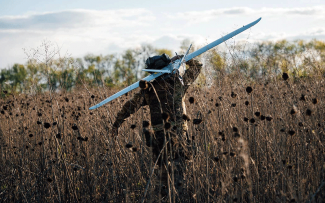Massive Ukrainian attacks on Crimea. Day 1168 of the war

![]()
The Russians broke through another Ukrainian line of defence on the eastern side of the Pokrovsk-Kostiantynivka road, where they penetrated their positions in a strip more than 5km wide to a depth of up to 5 km. After months of fighting, they also captured the area of the road junction near Malynivka, located on it. They continue their assault along three roads north of Toretsk, leaving part of the quarters in the northern and western parts of the town under Ukrainian control. They are increasingly attacking in small groups on motorbikes under the cover of drones, which is intended to ensure a high rate of advance while making it difficult for the defenders to detect the attackers in advance.
Further advances, were made by Russian forces on the other striking directions in the Donbas, but these did not change the overall situation – they were between Pokrovsk and Velyka Novosilka, where fighting began for the local Bahatyr road junction, in and south of Chasiv Yar, east of Siversk and north of Lyman. Minor terrain changes in Russia’s favour occurred on the right bank of the Oskil River north of Kupiansk, on islands in the mouth of the Dnipro south of Kherson, and on the border of Sumy Oblast with the Russian oblasts of Kursk and Belgorod. According to some sources, Ukrainian troops are expected to attempt to launch an attack from Sumy Ointo Russian territory from 5 May, hitting the border town of Tyotkino in Kursk Oblast, to the west of the earlier areas of fighting.
![]()
In late April and early May, the Russians launched a series of massive attacks on Kharkiv. Their drones hit the city for four days in a row. They mainly hit industrial infrastructure, but the attacks twice resulted in a significant number of civilian casualties. On 29 April, 47 people were wounded and on 2 May, 51 were wounded. On 2 May, Russia is thought to have used drones with thermobaric warheads. Kharkiv was again targeted on 6 May – the attack resulted, among other things, in a fire at one of Europe’s largest marketplaces, Barabashovo.
On 1 May, Russian drones struck Zaporizhzhia, where the main target was a rolling stock repair facility. Damage also occurred in other parts of the city and 33 people were injured. Representatives of Ukraine’s railways, the Ukrzaliznytsia, notified that this was a second attack on their technical facilities in recent days, after hitting repair facilities in Kyiv, which had not previously been reported. Railways remain the main means of transporting supplies to the Ukrainian army. Russian drones have also led to damage and civilian casualties in Odesa (30 April and 5 May), Mykolaiv and Cherkasy (3 May) and Kyiv (4 May). Russian missiles struck Bilhorod-Dnistrovskyi on the Dnipro (1 May) and Konotop (5 May), among others.
Russia again used over 1,000 strike drones and their imitators during a week. According to Ukrainian data, from the evening of 29 April to the morning of 6 May, the Russians deployed a total of 1,028 of them. 430 are thought to have been downed and 396 locationally lost. Thus, for the first time, more than 200 enemy drones may have hit their targets, indicating a progressive weakening of Ukrainian air defences. The number of missiles which Russia used remains at a relatively low level. During the period in question, they are thought to have used 12, with one of them shot down.
![]()
On 2 and 3 May, the Ukrainians carried out their biggest attacks in a year over Crimea and the neighbouring coastal part of Krasnodar Krai. According to Russian data, they used at least 255 strike drones (89 are thought to have been shot down over Crimea and 23 over the Black Sea on 2 May, and a day later 96 over the peninsula and 47 over Krasnodar Krai), as well as at least 23 surface drones and 11 missiles (eight Storm Shadow and three Neptun cruise missiles). However, the strike was unsuccessful – it is likely that none of the missiles hit a military facility or critical infrastructure. However, one of the surface drones, according to a message from the Ukrainian Military Intelligence Service (HUR) equipped with a US AIM-9 Sidewinder missile, managed to shoot down an Su-30SM fighter jet which was attempting to eliminate the drones. This is the first case of its kind in history (in December 2024, Ukrainian surface drones shot down two Russian helicopters). However, President Volodymyr Zelensky’s claim (repeated a day later by HUR chief Kyrylo Budanov) that a second Russian fighter had also been downed has not yet been confirmed.
Ukrainian drone attacks on Russian territory resulted in damage to the aerospace and naval instrumentation plant in Murom in Vladimir Oblast (30 April) and the Strela plant in Bryansk oblast, which manufactures electrical equipment (including transformers) (4 May). In contrast, strikes on Moscow on 5 and 6 May were unsuccessful.
On 30 April, hackers working for HUR launched a two-day cyberattack on the infrastructure of key Russian internet providers, including SibSet. The DDoS attacks overloaded and shut down SibSet’s servers in four Siberian cities: Novosibirsk, Novokuznetsk, Kemerovo and Krasnoyarsk.
![]()
On 30 April, the State Service for Special Communications and Information Protection published a report on Russian cyberattacks. In 2023, 2,541 cyberattacks against Ukraine were recorded, rising to 4,315 a year later, a jump of 69.8%. The strikes were often coordinated with military moves to destabilise the state and weaken public morale. The following types of activity were prevalent: DDoS attacks, the use of malware (e.g. WhisperGate, HermeticWiper) destroying data and crippling IT systems, phishing campaigns aimed at stealing credentials or spreading malware, attacks on critical infrastructure (especially the energy sector). Most of the incidents were attributed to hacking groups linked to Russia, such as Sandworm, Fancy Bear or Killnet. Activities of independent groups or those supported by other countries were also observed, which used the chaos of the war for their own purposes, such as data theft or blackmail. Despite the large scale of the attacks, Ukraine has shown resilience through rapid response, international cooperation and support from the private sector (e.g. Microsoft, Cisco).
![]()
On 30 April, the Reuters news agency, citing South Korean intelligence data, reported that around 600 North Korean soldiers had been killed in the fighting in Ukraine, with a total of around 15,000 of their servicemen sent to the frontline.
On 2 May, the foreign ministry of the Togolese Republic, on the basis of a report by the Ukrainian authorities, reported that Togolese nationals participating in armed activities on the side of the Russian Federation had been taken into Ukrainian captivity. Among those captured are young students who were allegedly lured to Russia by false scholarship offers. The authorities urged the Togolese to verify the authenticity of these offers and to contact the relevant services before travelling, especially to the Russian Federation.
![]()
On 30 April, the Ukrainian parliament voted in favour of an extension until 30 August this year of the validity of the voluntary return to military service for soldiers who have abandoned it once arbitrarily. This is expected to improve the staffing situation in military units, and the waiver of prosecution and punishment of first-time evaders is expected to encourage those who have left units to continue serving.
The authorities are continuing their efforts to uncover those responsible for the scandal involving the supply of more than 120,000 pieces of defective 120 mm calibre mortar ammunition, which was revealed last November. On 30 April, a Kyiv court ruled to arrest three people (defence ministry officials and the director of the Pavlohrad Chemical Plant). A day later, the deputy director of the Leonid Shiman Armaments Plant in Dnipropetrovsk Oblast was detained. The case has attracted considerable media attention, highlighting serious problems in the country’s defence sector. Despite the controversy, the Ukrainian defence ministry continues to cooperate with the latter entity. The head of the Defence Procurement Agency, Arsen Zhumadilov, reported that the plant is not a key supplier of mortar ammunition and that the quality problems have been resolved. He also stressed that breaking the contract could lead to the closure of the company, which is not in the interest of the state.
On 1 May, the Ukrainian Defence Industries corporation (Ukroboronprom) reported a consolidated net profit of more than 1.31 billion hryvnias (more than $31.5 million) for 2024. Part of these funds will be transferred to the state budget in the form of dividends, while the majority will be used for the development of arms production, its relocation, the increase of production capacity and the creation of new plants.
On 2 May, the Ukrainian law enforcement authorities uncovered two cases involving the illegal import of cars under the pretext of providing assistance to the army. After crossing the border, the cars were sold or dismantled for spare parts. In Lviv Oblast, 30 vehicles, documentation, cash and computer equipment were confiscated. Both cases indicate the existence of a widespread practice of abusing the status of a supplier of humanitarian aid to the Ukrainian Armed Forces to illegally import and dispose of cars.
![]()
Donald Trump’s administration has made its first decisions on the sale of military equipment and services to Kyiv. On 1 May, it notified the US Congress of its intention to export defence products worth $50 million in Direct Commercial Sales (DCS), the Kyiv Post reported. A day later, the State Department agreed to potentially sell $310 mn worth of training and technical equipment for F-16 fighter jets to Ukraine. According to The War Zone website, at the end of April the Americans handed over a number of disassembled (including engine and radar stripped) F-16s to the Ukrainians for spare parts. The disassembled aircraft arrived at Rzeszów-Jasionka on 26 April aboard an An-124 transport aircraft.
Kyiv is likely to receive an upgraded US Patriot air defence system, which was previously based in Israel, The New York Times reported on 4 May. According to the daily’s sources, the allies are also discussing the delivery of new Patriot launchers from Germany or Greece. So far, it was planned for Ukraine to receive a total of eight systems (batteries) of this type, of which six remain active (two have been withdrawn for repair). The reports were addressed by Reuters, which reported on 5 May that there were talks between the allies on the delivery of more Patriots from the US or Greece. On the same day, however, the messages from both media outlets were dismissed by the government in Athens – it stated that Greece was not planning this step and that no discussions were taking place. In contrast, Ukraine’s Defense Express reported that, as of April this year, there were “at least seven” systems active in Ukraine. The information chaos should be linked to a further intensification of Kyiv’s efforts to acquire new patriots, which also materialises in the form of applying information pressure on its partners.
Ukraine and the Czech Republic have agreed to the training of Ukrainian pilots on F-16 fighters and L-39 training aircraft, as announced by President Zelensky and Prime Minister Petr Fiala during the former’s visit to Prague on 4-5 May. The practical dimension of the agreement entails the training of Ukrainians on Czech L-39s. In the case of F-16s, which the Czech air force has never used, it is rather a call for cooperation to willing countries with these aircraft, as Prime Minister Fiala stressed, explaining Zelensky’s announcement of the creation of an F-16 school with the Czech Republic. Zelensky also announced that Kyiv expects to receive three million pieces of artillery ammunition this year, including 1.8 million under the so-called Czech initiative.






